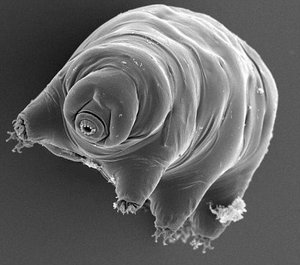The tiny creatures, known as tardigrades or water bears, are certainly strange-looking with their eight chubby legs, little claws and probing heads.
Some experts have compared their shape with jelly babies or moles but tardigrades they should not be judged by their 'cute' appearance. They are virtually indestructible - they will not die even if they are boiled, frozen, squeezed under pressure or desiccated.

|
| ©Daily Mail |
| Tardigrades or 'water bears' are the toughest creatures on the planet |
In fact, they can be completely dried out for years - and then spring back to life as if nothing had happened.
Now researchers have revealed that tardigrades - which usually measure no more than a millimetre in length and live in moss - have withstood the airless extremes of space.
A year ago, 3,000 of them were dried out and fired into space to see if they could handle the cosmic rays, a near vacuum and freezing cold.
Amazingly, after ten days, some of them did. They became the first animals to survive exposure in space without protection.
The experiment, supported by the European Space Agency, was headed by Dr Ingemar Jonsson, of the University of Kristianstad, Sweden.
'Our principal finding is that the space vacuum, which entails extreme dehydration, and cosmic radiation were not a problem for water bears,' he said. But admitted that exactly how they survived 'remains a mystery.'
The water bears were kept in a chamber on board the FOTON-M3 spacecraft as it orbited 270km above the Earth 270km.
A slide was opened to expose them to the vacuum and the cold. Some were also subjected to the Sun's UV rays which are 1,000 times stronger in space than on Earth and, incredibly, survived for the return trip. They continued to breed successfully.
Dr Jonsson and his colleagues in Stockholm, Stuttgart, and Cologne published the results of the space study in the journal Current Biology.
He said, 'The ultraviolet radiation in space is harmful to water bears, although a few individuals can survive even that.'
He believes that even if they suffered DNA damage, the little water bears could somehow repair it. The next challenge is to try to understand the creatures' 'exceptional tolerance' to extreme conditions, he said. It could help scientists learn how to treat cancer.
'All knowledge involving the repair of genetic damage is central to the field of medicine,' Dr Jonsson said.
'One problem with radiation therapy in treating cancer today is that healthy cells are also harmed. If we can document and show that there are special molecules involved in DNA repair in multicellular animals like tardigrades, we might be able to further the development of radiation therapy,' he added.
German scientist Dr Ralph Schill, who also worked on the project, said, 'I hoped they would make it but I could hardly have expected this result - you can't simulate some of the space conditions in the lab'.
Water bears exist in nearly all ecosystems of the world. What makes them unique is that they can survive repeated dehydration and can lose nearly all the water they have in their bodies.
When dehydrated, they enter into a dormant state in which the body contracts and metabolism ceases. In this death-like dormant state, water bears manage to maintain the structures in their cells until water is available to 'reactivate' them.
In 1998, Japanese scientists subjected the creatures to pressures up to 6,000 greater than our atmosphere. They lived. In tests, they have also survived X-rays and being frozen to just above absolute zero - that's minus 273.15C, the coldest temperature possible.
'No animal has survived open space before,' says developmental biologist Bob Goldstein of the University of North Carolina.
'The finding that animals survived rehydration after days in open space - and then produced viable embryos as well - is really remarkable.'



Reader Comments
to our Newsletter